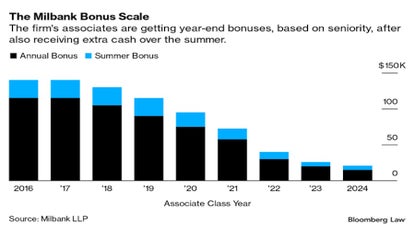Introduction: Navigating Legal Compensation
This guide provides a high-level overview of key legal compensation data and trends. It is tailored to serve a broad spectrum of professionals in the legal domain, catering to the strategic needs of legal hiring managers and HR experts (our esteemed clients) as well as addressing the career aspirations of skilled legal practitioners (our valued talent). We cover:
- Differences between in-house and law firm salaries
- Current trends in legal compensation
- Role-specific insights and variations in pay
- Legal professionals’ satisfaction with their compensation
- Geographical factors influencing remuneration
- Strategies for negotiating legal salaries
- A look at the future of legal compensation
- Resources for Further Exploration
By leveraging comprehensive data and industry insights from our network and publicly available sources, Legal.io aims to provide a well-rounded perspective that is invaluable for both sides of the hiring equation. Legal professionals seeking to access the full dataset, including individual data points, can do so by adding their salary here.
This document is only a starting point: we’ve included a wealth of tools, templates and links to role-specific data and other crucial information. Whether you're seeking to attract top legal talent or strategizing to understand your worth in the market, this guide is an indispensable resource, designed to empower you with clarity and confidence in a world where compensation is more than a number – it's a statement of value.
Understanding Legal Compensation: A Sector-Wide View
As of 2024, there are more than 1.33M active lawyers in the United States. While attorney roles traditionally command the highest compensation, there’s also an increasing group of highly paid individuals amongst the 750,000+ US-based professionals that are not licensed attorneys but are working in paralegal, legal operations and compliance roles.
In addition to role-based differences in compensation, compensation structures differ notably depending on the type of employer. In-house positions, law firms, and government roles come with different salary expectations, each mirroring the unique dynamics and expectations of these distinct work environments.
Going beyond the financial aspects, these work environments present a very different option in terms of work culture and professional growth opportunities, a distinction that should be top of mind when making career or hiring decisions in the legal field.
Law Firm Compensation
Entering a law firm has long been synonymous with high earning potential, marked by six-figure salaries and significant bonuses linked to demanding billable hour quotas.
This is definitely the case for roles in Big Law, where starting salaries for associates can now reach upward of $200,000, with 8th year associates commanding over $500,000 in total compensation. Senior positions garner bonuses and profit shares that significantly boost overall compensation packages, acknowledging their considerable contributions to firm profitability. The Cravath scale, a system used by US law firms to determine attorney salaries, looks as follows for the year 2024:
| Class | Salary | Annual Bonus | Total |
|---|---|---|---|
| 1st Year | $225,000 | $20,000 | $245,000 |
| 2nd Year | $235,000 | $30,000 | $265,000 |
| 3rd Year | $260,000 | $57,500 | $317,500 |
| 4th Year | $310,000 | $75,000 | $385,000 |
| 5th Year | $365,000 | $90,000 | $455,000 |
| 6th Year | $390,000 | $105,000 | $495,000 |
| 7th Year | $420,000 | $115,000 | $535,000 |
| 8th Year | $435,000 | $115,000 | $550,000 |
However, smaller law firms and mid-market players typically offer significantly lower compensation, with bonuses more reflective of the firm's scale and revenue. These environments may present fewer billable hours and a greater emphasis on work-life balance, but often lack the financial heft of their larger counterparts.
In-House Compensation
The corporate in-house realm differs significantly from the traditional law firm path. While average salaries are lower than Big Law, overall compensation is in part made up for by bonuses and other incentives. These benefits often correlate more with company performance and collaborative success rather than individual billable achievements.
In major tech firms and FAANG companies, this trend can be even more pronounced, with compensation packages that lean heavily on stock options and grants, positioning in-house legal professionals to substantially benefit from market successes in case of a liquidity event such as an IPO.
Legal professionals at these high-growth tech companies often command significantly higher compensation packages than in-house professionals working in smaller legal departments. The location, industry and risk profile of the employer also impact supply and demand for expertise, creating further variances in compensation.
Government & Public Interest
In government roles, attorney compensation significantly varies based on the level of government (federal, state, or local), geographical location, and specific legal expertise. Although these roles are generally perceived to offer lower salaries compared to the private sector, they are compensated with advantages like job security and comprehensive benefits like pensions and health insurance, contributing to their appeal among legal professionals.
Federal government attorneys are paid according to the General Schedule (GS) pay scale, with entry-level positions typically starting at GS-11 or GS-12 levels and compensation from $55,000 to $80,000 annually, depending on the location. More experienced attorneys can attain higher GS levels, potentially earning over $130,000.
State and local government attorneys have salaries determined by their own specific scales, leading to wide variations. Attorneys working in public interest law or for non-profit organizations often earn less than those in government roles, though this can depend on the specific organization and funding sources.
These stark differences in compensation between the major types of employers of legal professionals highlight that the starting compensation and potential for growth differs tremendously depending on the career path a professional pursues. While compensation in the upper echelons of the profession is high, the average starting salary of a US-based attorney hovers around a much more modest $110,000.
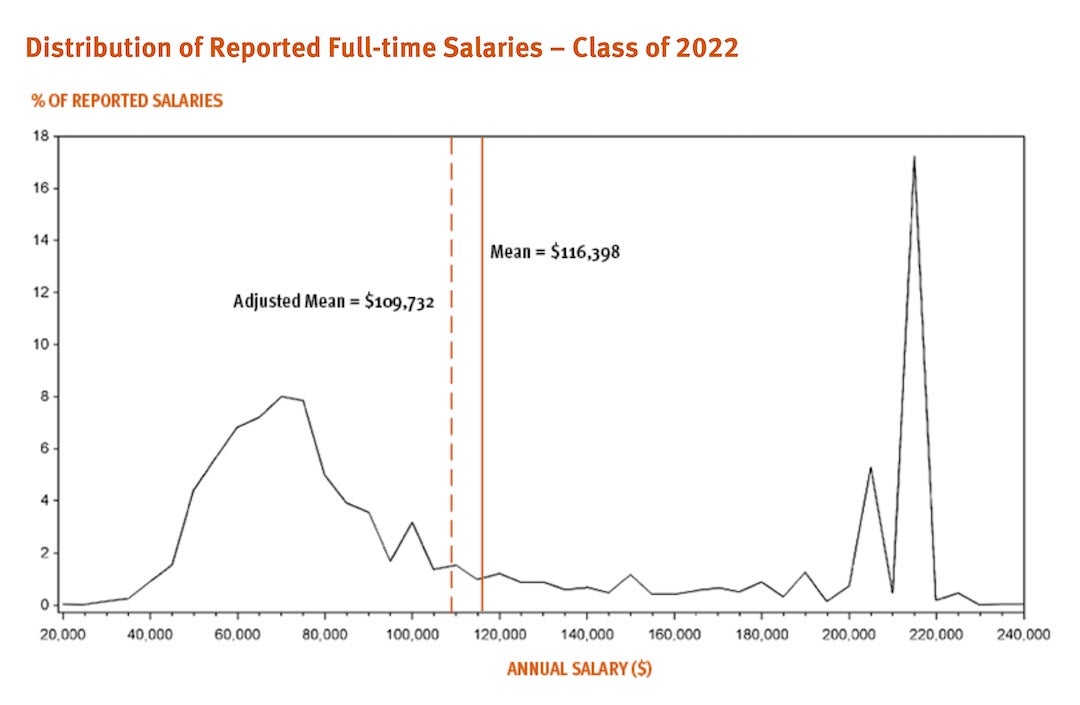
Current Trends in Legal Compensation
In the legal industry, compensation structures are constantly evolving in response to a variety of economic and sector-specific trends. These shifts manifest differently in in-house roles compared to big law firms, each adapting to their unique market forces and internal dynamics. These trends carry implications for career trajectories and organizational strategies alike.
Big Law
War for talent: In big law, there has been a notable trend of increasing base salaries, especially in top-tier firms. This is partly in response to a competitive market for top legal talent and a need to maintain prestige and appeal to high-performing graduates.
Performance-based Bonuses: Bonuses continue to be a significant part of compensation in big law, with a trend towards more sophisticated performance-based structures. These bonuses are not just tied to billable hours but also to factors like client acquisition, firm development activities, and contributions to firm culture.
Focus on Specialization: There’s a growing emphasis on specialization in certain high-demand areas of law, such as technology and intellectual property. Lawyers with expertise in these areas are commanding higher salaries due to the increased demand for their specialized skills.
In-House
Increased Desirability: Over time, in-house legal roles have grown in stature and desirability, increasingly seen as a preferred alternative to positions in big law firms. This shift is attributed to various factors, including the desire for better work-life balance, greater involvement in business strategy, and less pressure from billable hour requirements. In-house roles offer a unique opportunity for legal professionals to be more integrated into the business, providing strategic legal counsel directly influencing company decisions.
Salary Competitive but Balanced: While in-house salaries have been increasing, they do so with a view to maintaining a balance with other job benefits, like work-life balance and job security. This reflects a broader trend in the corporate world valuing holistic compensation packages over purely financial incentives.
Stock Compensation Growth: In the in-house sector, stock compensation has become an increasingly significant part of the package, particularly in tech and startup companies. As these companies grow, the potential value of stock options can be a substantial draw for legal talent.
Economic and Industry Factors
Economic Uncertainties: The global economy, impacted by factors such as geopolitical tensions and the aftermath of the COVID-19 pandemic, plays a significant role. Economic uncertainties can lead to more cautious compensation strategies, especially in sectors sensitive to economic cycles.
Technological Advancements: The legal industry’s adoption of technology influences compensation trends. There's a growing need for lawyers who are not only legally proficient but also tech-savvy, which can drive up compensation for those with these dual competencies.
Regulatory Environment: Changes in the regulatory landscape, especially in areas like data privacy, financial regulations, and environmental law, create demand for legal expertise in these fields, impacting salary structures and demand for specialized legal skills.
Client Expectations and Legal Service Delivery Models: The evolving expectations of clients, including demands for more cost-effective and efficient legal services, impact how law firms and in-house legal departments structure their compensation. There's a shift towards value-driven billing and away from traditional billable hour models, influencing how lawyers are compensated.
Role-Specific Compensation Insights
Attorneys
Attorney roles in the legal industry are as diverse as they are dynamic, encompassing a range of specializations and responsibilities. From high-powered corporate counsels to specialized roles like intellectual property or privacy lawyers, each position commands a unique compensation package reflective of its specific demands and expertise.
Senior roles such as General Counsels and Partners often top the compensation charts, given their strategic importance in organizations. On the other hand, specialized roles like Product Counsel or Real Estate Counsel highlight the industry's increasing need for niche expertise, each attracting distinct salary levels.
| Role | Total Compensation ($/yr) |
|---|---|
| Partner | $450,000 |
| General Counsel | $290,000 |
| Deputy General Counsel | $286,000 |
| Assistant / Associate General Counsel | $225,000 |
| Associate | $225,000 |
| Product Counsel | $210,000 |
| Privacy Counsel | $187,000 |
| Intellectual Property Counsel | $180,000 |
| Corporate Counsel | $178,000 |
| Commercial Counsel | $170,000 |
Other Legal Professionals
Beyond attorneys, the legal field is supported by a range of other legal professionals who play vital roles in the functioning of legal systems and organizations. These roles include legal operations managers, compliance managers, paralegals, and legal assistants, among others. While these positions might not require a law degree, they are integral to the efficiency and effectiveness of legal services.
The compensation for these roles varies, influenced by factors such as the complexity of tasks, level of expertise required, and the specific legal context in which they operate.
| Role | Total Compensation ($/yr) |
|---|---|
| Legal Operations | $150,000 |
| Contract Manager | $142,000 |
| Compliance Manager | $116,000 |
| Legal Assistant | $91,000 |
| Paralegal | $85,000 |
Legal professionals’ satisfaction with their compensation
Understanding compensation satisfaction among legal professionals is as critical as grasping the numerical data of salaries and bonuses. Through our community, we’ve captured the sentiment of over 1,000 legal professionals across various roles, regions, and sectors about how they feel concerning their financial remuneration.
The insights derived from the compensation satisfaction data portray a comprehensive picture of the sentiment within the legal industry. On a scale ranging from very dissatisfied to very satisfied, we find that a slight majority of legal professionals are at least somewhat satisfied with their compensation.
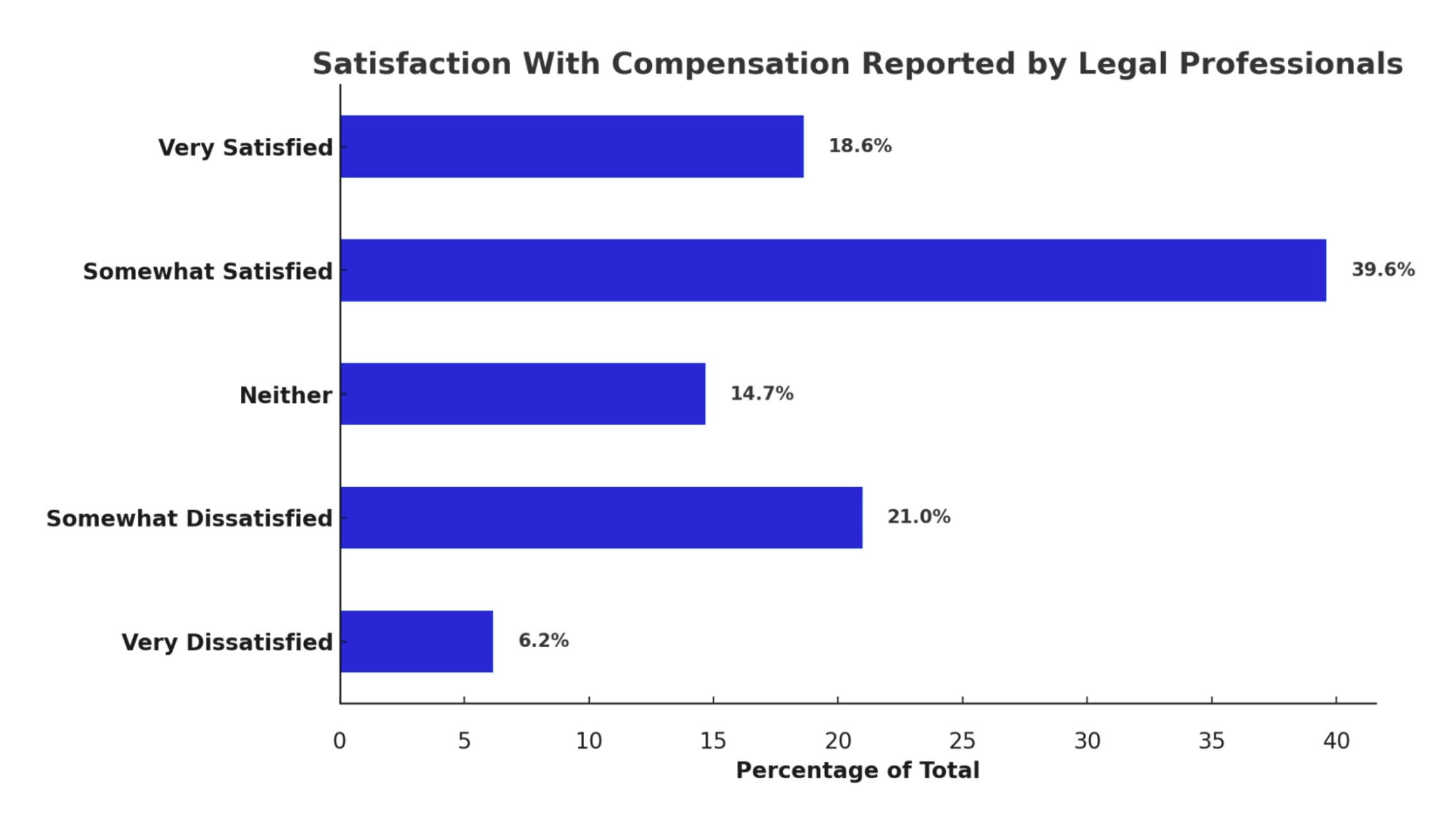
Notably, over 58% of respondents reported positive levels of satisfaction, with the data skewing towards the Somewhat Satisfied category. This tendency signifies that a significant proportion of legal professionals appreciate their compensation packages, reflecting factors such as competitive pay, firm reputation, and the apparent alignment of compensation with job demands and market value.
In contrast, approximately 27% of contributors expressed dissatisfaction. This dissatisfaction stems from various quarters – the pressure of billable hours, the disparity between their salary and the high cost of living in certain cities, the stress associated with demanding legal duties, or the comparison with peers in more lucrative sectors like Big Law or the high-growth tech industry. It becomes evident that for a subset of the legal workforce, there is a perceived gap between their contributions to their firms or companies and the financial recognition they receive.
The diversity in satisfaction signals an undercurrent of evolving expectations among legal professionals, who are weighing compensation against other quality-of-life considerations, including work-life balance, job security, and the non-monetary aspects of their roles. For some, the fulfillment derived from their work environment, work culture, and the opportunities for professional growth may offset any disenchantment with their financial compensation.
Geographic Variations in Legal Compensation
The salaries of legal professionals in the United States vary significantly by state and metropolitan area. This variation is influenced by a combination of factors, including the cost of living, demand for legal services, state-specific legal markets, and the presence of large law firms or corporations.
Best Paying States
The top states for lawyer salaries are predominantly located in regions with high costs of living and significant concentrations of corporate and legal activity. The District of Columbia, California, New York, and Massachusetts lead the pack, reflecting their status as legal and economic powerhouses. In these states, median lawyer salaries often exceed $160,000, with the District of Columbia topping the chart at nearly $178,000.
Paralegals in these states also enjoy comparatively higher salaries. For instance, in the District of Columbia, the median salary for paralegals stands at around $87,000, significantly above the national average. These numbers are reflective of the intense competition for skilled legal professionals and the high-stakes nature of legal work in these regions.
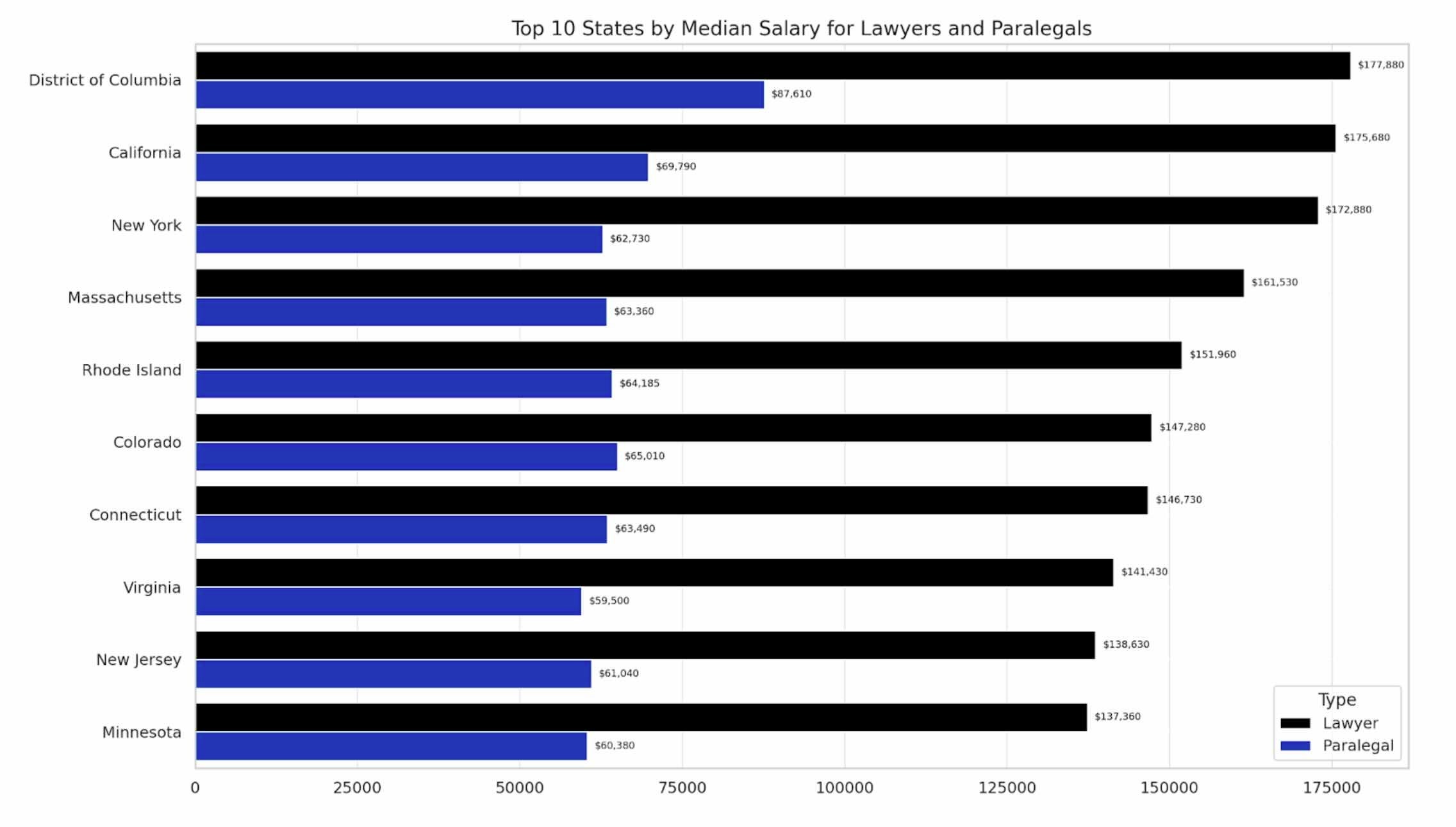
Worst Paying States
On the other end of the spectrum, states like Mississippi, Montana, and West Virginia represent the lower end of the salary range for lawyers in the U.S. In these states, median salaries for lawyers are substantially lower, with Mississippi at the bottom with a median salary around $80,000. This is almost half of what lawyers earn in the top states, illustrating the significant geographical disparity in legal compensation.
Paralegals in these states also face lower compensation, with median salaries often falling below $50,000. However, it’s crucial to consider the cost of living in these areas, which is generally lower than in states like New York or California. This cost of living adjustment somewhat mitigates the lower salary figures, though the difference in absolute terms remains substantial.
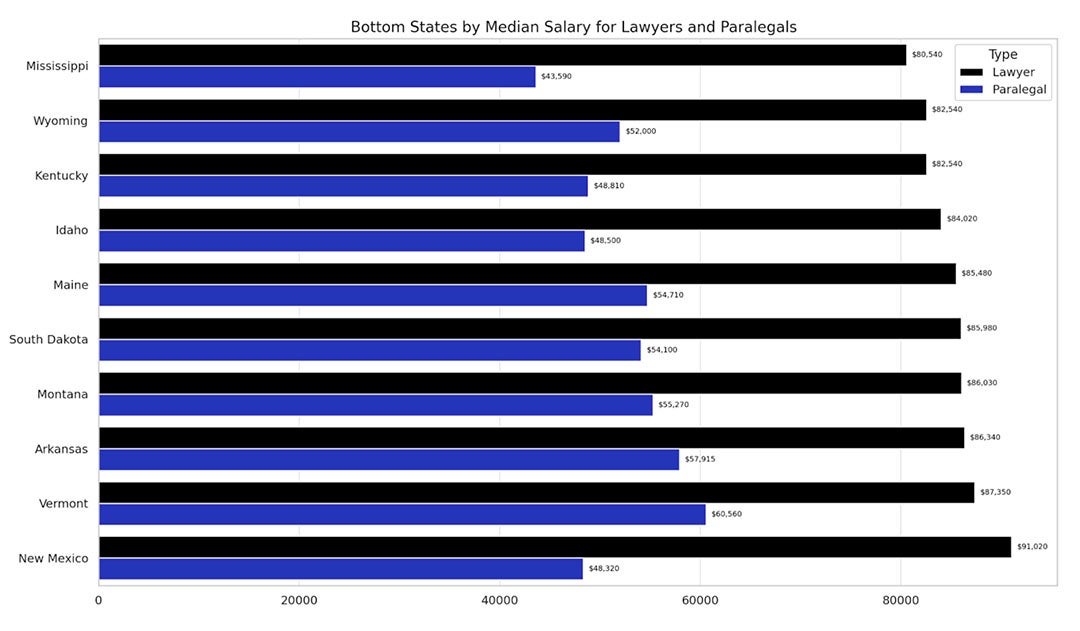
Strategies for Negotiating Legal Salaries
Negotiating salaries in the legal sector requires a nuanced approach, balancing the needs and expectations of both the employers (buyers) and legal professionals (talent). For employers, the challenge lies in attracting top talent without overshooting budgets, while for legal professionals, the goal is to secure fair and competitive compensation. Here are some strategies for both parties to navigate these negotiations effectively.
For Employers: Attracting Top Talent Within Budget
Understand Market Rates: Stay informed about current compensation trends in the legal industry. Understanding what competitors offer can help in creating competitive yet sustainable salary packages.
Highlight Total Compensation Package: Beyond the base salary, emphasize the total compensation package, including bonuses, benefits, and career development opportunities. This holistic approach can be more appealing than a high salary alone.
Flexibility and Work-Life Balance: In an era where work-life balance is highly valued, offering flexible working conditions can be a powerful negotiation tool. It can compensate for any limitations in the salary package.
Tailor Offers to Individual Needs: Understand the candidate's priorities. For some, career growth opportunities might be as crucial as the salary. Tailoring offers to meet these individual preferences can make them more attractive.
Transparent Communication: Be transparent about the budget constraints and how salary structures are determined. Honest discussions can foster trust and lead to mutually beneficial agreements.
For Legal Professionals: Securing Fair and Competitive Compensation
Do Your Research: Understand your worth by researching market standards for someone with your experience and skills. Websites, industry surveys, and networking can provide valuable insights.
Articulate Your Value: Clearly communicate your achievements, skills, and how you can contribute to the organization. Demonstrating your value can justify your salary expectations.
Consider the Entire Package: Look beyond the base salary. Consider benefits like health insurance, retirement plans, bonuses, and non-monetary benefits like flexible working conditions.
Be Prepared to Negotiate: Don’t be afraid to negotiate. If an offer doesn’t meet your expectations, articulate why and what would make it acceptable. Be specific in your counter-offer.
Understand When to Walk Away: Recognize if the negotiation reaches a point where your minimum requirements are not met. It’s essential to know when to walk away from an offer that undervalues your contribution.
For Both Parties
Successful salary negotiations in the legal field hinge on mutual understanding and respect. Both employers and legal professionals should approach these discussions with a clear understanding of their goals and limitations.
By focusing on open communication, flexibility, and a comprehensive understanding of the market, both parties can navigate these negotiations towards successful outcomes. Remember, the aim is to reach an agreement that acknowledges the value of the legal professional while aligning with the organization's strategic objectives and resources.
Looking Ahead: The Future of Legal Compensation
The legal industry continues to be shaped by technological advancements, economic shifts, and evolving professional expectations. These factors are poised to drive significant changes in legal compensation structures. Here are some forward-looking predictions:
-
Increased Transparency: The call for openness in compensation is expected to intensify, bolstered by a cultural shift towards salary openness and the enactment of salary transparency laws in various regions.
-
Flexible Models: There's a clear movement towards compensation packages that offer more than just a paycheck. Benefits like the ability to work remotely and flexible hours are becoming increasingly commonplace.
-
Value of Tech Proficiency: As legal tech gains momentum, professionals with technology expertise are likely to see their market value—and consequently, their pay—rise.
-
Law Firm Rate Dynamics: As clients become more cost-conscious and alternative legal service providers enter the market, law firms are facing pressure to justify their rates. This trend is pushing firms to reevaluate their pricing models and to find innovative ways to deliver value without compromising on service quality.
-
Specialization Premium: Specialists in areas like data privacy, cybersecurity, and artificial intelligence are in high demand, and this trend is expected to persist, reflecting in their compensation.
As we shift towards a more transparent, flexible, and technology-driven industry, Legal.io provides the necessary resources and tools to help you adapt and thrive. Whether you're seeking competitive compensation or the ideal candidate for your legal team, Legal.io is your partner in navigating the evolving landscape of legal work and compensation.







